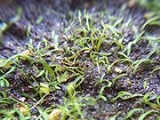
Utricularia fulva
Encyclopedia
Utricularia fulva is a small to medium sized annual
carnivorous plant
that belongs to the genus
Utricularia. U. fulva is endemic to Australia
, where it appears to be largely restricted to the Northern Territory
, specifically the Arnhem Land
sandstone escarpment. It grows as a terrestrial or subaquatic plant in or near sandy stream beds. It was originally described and published by Ferdinand von Mueller
in 1858.
Annual plant
An annual plant is a plant that usually germinates, flowers, and dies in a year or season. True annuals will only live longer than a year if they are prevented from setting seed...
carnivorous plant
Carnivorous plant
Carnivorous plants are plants that derive some or most of their nutrients from trapping and consuming animals or protozoans, typically insects and other arthropods. Carnivorous plants appear adapted to grow in places where the soil is thin or poor in nutrients, especially nitrogen, such as acidic...
that belongs to the genus
Genus
In biology, a genus is a low-level taxonomic rank used in the biological classification of living and fossil organisms, which is an example of definition by genus and differentia...
Utricularia. U. fulva is endemic to Australia
Australia
Australia , officially the Commonwealth of Australia, is a country in the Southern Hemisphere comprising the mainland of the Australian continent, the island of Tasmania, and numerous smaller islands in the Indian and Pacific Oceans. It is the world's sixth-largest country by total area...
, where it appears to be largely restricted to the Northern Territory
Northern Territory
The Northern Territory is a federal territory of Australia, occupying much of the centre of the mainland continent, as well as the central northern regions...
, specifically the Arnhem Land
Arnhem Land
The Arnhem Land Region is one of the five regions of the Northern Territory of Australia. It is located in the north-eastern corner of the territory and is around 500 km from the territory capital Darwin. The region has an area of 97,000 km² which also covers the area of Kakadu National...
sandstone escarpment. It grows as a terrestrial or subaquatic plant in or near sandy stream beds. It was originally described and published by Ferdinand von Mueller
Ferdinand von Mueller
Baron Sir Ferdinand Jacob Heinrich von Mueller, KCMG was a German-Australian physician, geographer, and most notably, a botanist.-Early life:...
in 1858.

